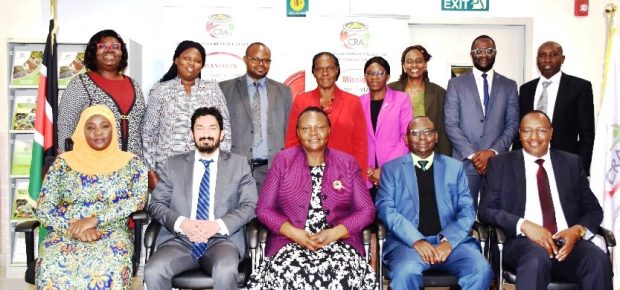
IMF Meets CRA to Understand Kenya’s Revenue Sharing
On 19th June 2025, the Commission on Revenue Allocation (CRA) hosted Mr. Samir Jahan from the International Monetary Fund (IMF), as part of the IMF’s ongoing governance diagnostic mission in Kenya. The high-level consultative meeting was held following a direct request from the H.E. Hon. Dr Musalia Mudavadi, EGH., who tasked CRA to provide a comprehensive overview of the country’s revenue-sharing framework — including historical context, legal underpinnings, emerging issues and future directions.
CRA Chairperson, CPA Mary Chebukati, led the Commission’s team, joined by Commissioners Hadija Juma, Muasya Mutiso, Jonas Kuko, Acting CEO CPA Roble Nuno, and senior management. The engagement was timely, taking place just days after the Senate approved the Fourth Basis for Revenue Sharing Among County Governments, which is now awaiting deliberation by the National Assembly.

CRA’s mandate in revenue sharing
Kenya’s revenue-sharing framework is grounded in Article 216 of the Constitution. It mandates CRA to:
- Recommend the basis for equitable sharing of nationally raised revenue between the national and county governments (vertical sharing); and
- Recommend the formula for revenue sharing among the counties (horizontal sharing).
Over 12 years of devolution, CRA has developed and submitted four formulas to Parliament. While the First Basis (2013–2017) sailed through without much resistance, the Second (2017–2020), Third (2020–2025), and now the Fourth Basis (2025–2030) faced amendments before approval, highlighting the increasingly complex political and economic considerations at play.
Kenya’s Legal and Constitutional Revenue-Sharing Framework
Revenue sharing in Kenya is governed by a robust legal and constitutional framework:
- Articles 202–203: Define equitable share transfers and set minimum thresholds (15% of the most recent audited national revenues to counties).
- Article 209 and CRA Act, 2011: Define the scope of shareable revenues, which include taxes and authorized revenues but exclude trust and contingency funds.
- Article 187(2)(a): Anchors the principle that finance should follow functions.
- Public Finance Management Act (PFMA) Sections 190–191: Define timelines and procedures for CRA’s recommendations and Parliament’s enactment of the Division of Revenue Bill (DoRB) and County Allocation of Revenue Bill (CARB).
- Article 217(4): Specifies that National Assembly may amend or reject Senate resolutions with a two-thirds majority.
Breakdown of the Fourth Basis for Horizontal Sharing (2025/26–2029/30)
The Fourth Basis seeks to balance equity, service delivery and development needs. The parameter weights, as proposed by CRA and amended by Senate, are as follows:

Key Challenges in Kenya’s Revenue-Sharing Framework
Despite constitutional safeguards, several critical challenges persist:
- Underperformance in national revenue: Unrealized revenue projections reduce the pool available for sharing.
- Debt servicing pressures: Public debt repayments are crowding out development and discretionary spending.
- High personnel costs: County governments spend disproportionately on wages, squeezing development budgets.
- Frequent supplementary budgets: Counties frequently revise their budgets mid-year due to lowered revenue expectations or increased expenditure.
- Delayed disbursements: Equitable share transfers from the National Treasury are often late, disrupting service delivery.
These issues raise fundamental questions: Is Kenya truly living up to the principle of funds following functions? How can fiscal responsibility be enforced across both tiers of government?
CRA’s Strategic Role Beyond Revenue Sharing Formula
While revenue-sharing formulas is our Principal Mandate, the Commission, also plays a broader strategic role, including:
- Recommending sustainable revenue sources for both levels of government.
- Promoting fiscal responsibility and transparency.
- Advising on bills with financial implications for counties (per Article 205).
- Periodically reviewing and publishing criteria to identify marginalized areas for Equalisation Fund allocations.
Looking Ahead: IMF’s Interest and CRA’s Outlook
The IMF’s diagnostic mission, is a recognition of Kenya’s evolving public finance architecture under devolution. CRA’s insights into both the technical formulae and real-world implementation challenges offer valuable lessons — not only for Kenya but for other countries managing intergovernmental fiscal transfers.
As Parliament deliberates on the Fourth Basis, the stakes are high. The process must strike a balance between population equity, development needs and fairness to marginalized regions, all while navigating competing political interests.
As CRA Chairperson CPA Mary Chebukati emphasized during the meeting:
“We have walked a 12-year journey of learning, adjusting and maturing our revenue-sharing model. Now more than ever, we must ensure that the system works for every Kenyan, no matter their county.”
The CRA–IMF meeting offered a critical platform to reflect on the successes, struggles and strategic direction of Kenya’s revenue-sharing journey. With the Fourth Basis nearing full legislative approval, the next five years will test whether the formula’s promise translates into equitable service delivery and sustainable development across Kenya’s 47 county governments.
